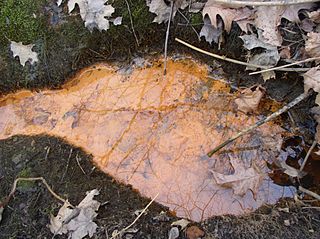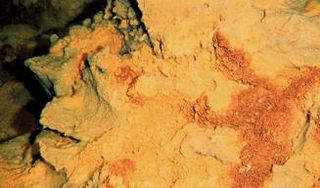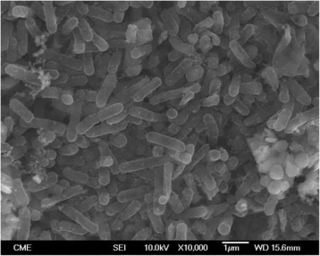Bioleaching is the extraction or liberation of metals from their ores through the use of living organisms. Bioleaching is one of several applications within biohydrometallurgy and several methods are used to treat ores or concentrates containing copper, zinc, lead, arsenic, antimony, nickel, molybdenum, gold, silver, and cobalt.

Acidithiobacillus is a genus of the Acidithiobacillia in the phylum "Pseudomonadota". This genus includes ten species of acidophilic microorganisms capable of sulfur and/or iron oxidation: Acidithiobacillus albertensis, Acidithiobacillus caldus, Acidithiobacillus cuprithermicus, Acidithiobacillus ferrianus, Acidithiobacillus ferridurans, Acidithiobacillus ferriphilus, Acidithiobacillus ferrivorans, Acidithiobacillus ferrooxidans, Acidithiobacillus sulfuriphilus, and Acidithiobacillus thiooxidans.A. ferooxidans is the most widely studied of the genus, but A. caldus and A. thiooxidans are also significant in research. Like all "Pseudomonadota", Acidithiobacillus spp. are Gram-negative and non-spore forming. They also play a significant role in the generation of acid mine drainage; a major global environmental challenge within the mining industry. Some species of Acidithiobacillus are utilized in bioleaching and biomining. A portion of the genes that support the survival of these bacteria in acidic environments are presumed to have been obtained by horizontal gene transfer.
Ferroglobus is a genus of the Archaeoglobaceae.

Iron-oxidizing bacteria are chemotrophic bacteria that derive energy by oxidizing dissolved iron. They are known to grow and proliferate in waters containing iron concentrations as low as 0.1 mg/L. However, at least 0.3 ppm of dissolved oxygen is needed to carry out the oxidation.

Ferroplasma is a genus of Archaea that belong to the family Ferroplasmaceae. Members of the Ferroplasma are typically acidophillic, pleomorphic, irregularly shaped cocci.
Biomining is the technique of extracting metals from ores and other solid materials typically using prokaryotes, fungi or plants. These organisms secrete different organic compounds that chelate metals from the environment and bring it back to the cell where they are typically used to coordinate electrons. It was discovered in the mid 1900s that microorganisms use metals in the cell. Some microbes can use stable metals such as iron, copper, zinc, and gold as well as unstable atoms such as uranium and thorium. Large chemostats of microbes can be grown to leach metals from their media. These vats of culture can then be transformed into many marketable metal compounds. Biomining is an environmentally friendly technique compared to typical mining. Mining releases many pollutants while the only chemicals released from biomining is any metabolites or gasses that the bacteria secrete. The same concept can be used for bioremediation models. Bacteria can be inoculated into environments contaminated with metals, oils, or other toxic compounds. The bacteria can clean the environment by absorbing these toxic compounds to create energy in the cell. Bacteria can mine for metals, clean oil spills, purify gold, and use radioactive elements for energy.

The outflow of acidic liquids and other pollutants from mines is often catalysed by acid-loving microorganisms; these are the acidophiles in acid mine drainage.

The class Zetaproteobacteria is the sixth and most recently described class of the Pseudomonadota. Zetaproteobacteria can also refer to the group of organisms assigned to this class. The Zetaproteobacteria were originally represented by a single described species, Mariprofundus ferrooxydans, which is an iron-oxidizing neutrophilic chemolithoautotroph originally isolated from Kamaʻehuakanaloa Seamount in 1996 (post-eruption). Molecular cloning techniques focusing on the small subunit ribosomal RNA gene have also been used to identify a more diverse majority of the Zetaproteobacteria that have as yet been unculturable.
Iron:rusticyanin reductase is an enzyme with systematic name Fe(II):rusticyanin oxidoreductase. This enzyme catalyses the following chemical reaction
Syntrophomonas wolfei is a bacterium. It is anaerobic, syntrophic and fatty acid-oxidizing. It has a multilayered cell wall of the gram-negative type.

Ferroplasma acidiphilum is an acidophilic, autotrophic, ferrous iron-oxidizing, cell wall-lacking, mesophilic member of the Ferroplasmaceae. F. acidophilum is a mesophile with a temperature optimum of approximately 35 °C, growing optimally at a pH of 1.7. F. acidophilum is generally found in acidic mine tailings, primarily those containing pyrite (FeS2). It is especially abundant in cases of severe acid mine drainage, where other organisms such as Acidithiobacillus and Leptospirillum lower the pH of the environment to the extent that F. acidophilum is allowed to flourish.

Acidimicrobium ferrooxidans is a bacterium, the type species of its genus. It is a ferrous-iron-oxidizing, moderately thermophilic and acidophilic bacterium. A complete genome of one strain, DSM 10331 isolated in Iceland from hot spring runoff water, has been resolved.
Geopsychrobacter electrodiphilus is a species of bacteria, the type species of its genus. It is a psychrotolerant member of its family, capable of attaching to the anodes of sediment fuel cells and harvesting electricity by oxidation of organic compounds to carbon dioxide and transferring the electrons to the anode.
Sulfolobus metallicus is a coccoid shaped thermophilic archaeon. It is a strict chemolithoautotroph gaining energy by oxidation of sulphur and sulphidic ores into sulfuric acid. Its type strain is Kra 23. It has many uses that take advantage of its ability to grow on metal media under acidic and hot environments.
Acidithiobacillus caldus formerly belonged to the genus Thiobacillus prior to 2000, when it was reclassified along with a number of other bacterial species into one of three new genera that better categorize sulfur-oxidizing acidophiles. As a member of the Gammaproteobacteria class of Pseudomonadota, A. caldus may be identified as a Gram-negative bacterium that is frequently found in pairs. Considered to be one of the most common microbes involved in biomining, it is capable of oxidizing reduced inorganic sulfur compounds (RISCs) that form during the breakdown of sulfide minerals. The meaning of the prefix acidi- in the name Acidithiobacillus comes from the Latin word acidus, signifying that members of this genus love a sour, acidic environment. Thio is derived from the Greek word thios and describes the use of sulfur as an energy source, and bacillus describes the shape of these microorganisms, which are small rods. The species name, caldus, is derived from the Latin word for warm or hot, denoting this species' love of a warm environment.

Acidithiobacillus thiooxidans, formerly known as Thiobacillus thiooxidans until its reclassification into the newly designated genus Acidithiobacillus of the Acidithiobacillia subclass of Pseudomonadota, is a Gram-negative, rod-shaped bacterium that uses sulfur as its primary energy source. It is mesophilic, with a temperature optimum of 28 °C. This bacterium is commonly found in soil, sewer pipes, and cave biofilms called snottites. A. thiooxidans is used in the mining technique known as bioleaching, where metals are extracted from their ores through the action of microbes.
Acidithrix ferrooxidans is a heterotrophic, acidophilic and Gram-positive bacterium from the genus Acidithrix. The type strain of this species, A. ferrooxidans Py-F3, was isolated from an acidic stream draining from a copper mine in Wales. This species grows in a variety of acidic environments such as streams, mines or geothermal sites. Mine lakes with a redoxcline support growth with ferrous iron as the electron donor. "A. ferrooxidans" grows rapidly in macroscopic streamer, producing greater cell densities than other streamer-forming microbes. Use in a bioreactors to remediate mine waste has been proposed due to cell densities and rapid oxidation of ferrous iron oxidation in acidic mine drainage. Exopolysaccharide production during metal substrate metabolism, such as iron oxidation helps to prevent cell encrustation by minerals.

Microbial oxidation of sulfur is the oxidation of sulfur by microorganisms to build their structural components. The oxidation of inorganic compounds is the strategy primarily used by chemolithotrophic microorganisms to obtain energy to survive, grow and reproduce. Some inorganic forms of reduced sulfur, mainly sulfide (H2S/HS−) and elemental sulfur (S0), can be oxidized by chemolithotrophic sulfur-oxidizing prokaryotes, usually coupled to the reduction of oxygen (O2) or nitrate (NO3−). Anaerobic sulfur oxidizers include photolithoautotrophs that obtain their energy from sunlight, hydrogen from sulfide, and carbon from carbon dioxide (CO2).
Sulfobacillus thermosulfidooxidans is a species of bacteria of the genus Sulfobacillus. It is an acidophilic, mixotrophic, moderately thermophilic, Gram-positive, sporulating facultative anaerobe. As its name suggests, it is capable of oxidizing sulfur.

Sulfobacillus is a genus of bacteria containing six named species. Members of the genus are Gram-positive, acidophilic, spore-forming bacteria that are moderately thermophilic or thermotolerant. All species are facultative anaerobes capable of oxidizing sulfur-containing compounds; they differ in optimal growth temperature and metabolic capacity, particularly in their ability to grow on various organic carbon compounds.









